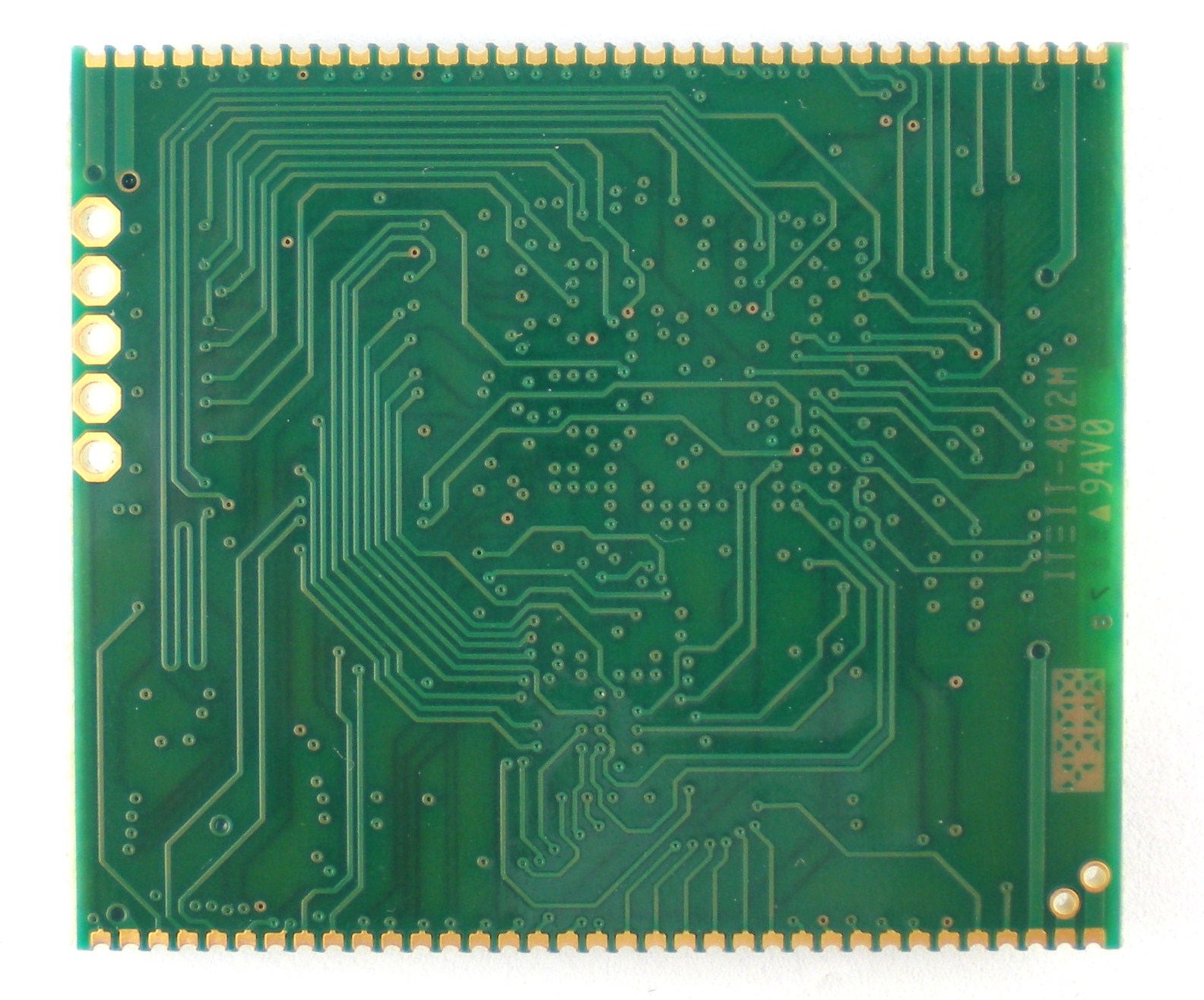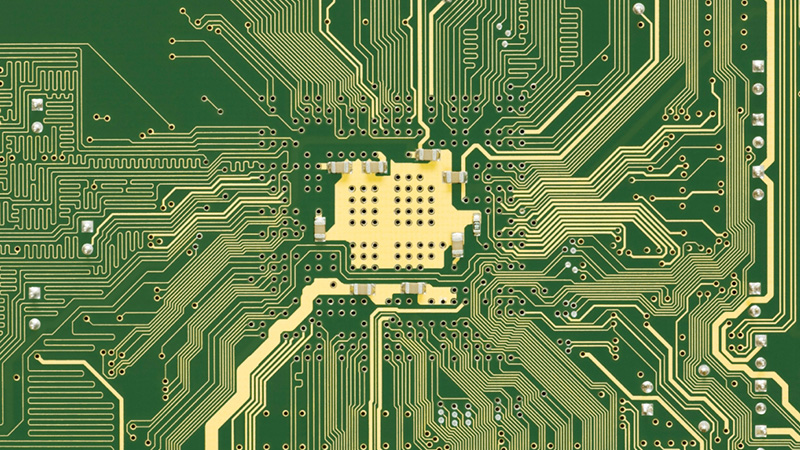
PCB DesignFlexible Circuit Design
Overview Examines the stress concentration properties of a design. The stress concentration properties are the sole cause of mechanical failure (i.e., cracked/broken conductors, torn insulation, etc.) in flex circuits. To avoid stress concentration points, the circuit structure should not be altered in or immediately adjacent to the bend area. There shall be no variation in width, thickness, or orientation of conductors in the bend area, there shall be no plating or coating, no openings in the covering or outer insulation, and there shall be no holes of any kind in the bend area.
bending ratio
Determine and evaluate the minimum bend ratio for your design. The bend ratio is the best indicator of whether a flex circuit will experience problems during use. The bend ratio is bend radius - circuit thickness (Table 1).
Optimum Bending Ratio for Different Structures
conductor routing
Conductors should pass through the bend area as much as possible and keep the conductor perpendicular to the face of the bend (Figure 1). Doing this minimizes the stress on the conductors when they are bent, which maximizes circuit life. Conductor changes should always be made with curved curves rather than sharp corners. When it is not possible to redirect the conductor with a curved curve, it is better to use two angles of 45° to redirect the conductor, followed by one angle of 90° (Figure 2).
Conductors should pass through the bending area as much as possible
2 angles of 45° are better than 1 angle of 90° to redirect conductors when curved curves cannot be used
It is best to place small conductors inside the bend area. Small conductors (<0.007”) are better able to withstand compression than tension. Placing such conductors on the inside of the bend area can reduce or avoid tension. Do not stack conductors on multiple layers to avoid I-shaped Beam Effect. Stacking conductors necessarily increases the overall thickness of the circuit, thereby reducing flexibility and the ability of the circuit to bend reliably.
conductor
Flexible circuit conductors are made using a photolithographic process, which starts with a single sheet of copper. Conductors are formed by masking the desired conductive paths and then chemically removing the unwanted copper, leaving the desired circuit pattern. The etchant will dissolve the unmasked copper and will also etch away the edges of the conductors, a phenomenon known as "undercutting".
As the thickness of the copper foil increases, the amount of undercut will also increase. So it is difficult for flex circuit manufacturers to make very small conductors on very thick copper foil. There are also differences in the etching process (mainly the etchant strength varies with the amount of copper in the solution). Therefore, designers must account for processing tolerances in trace width (and pitch). For best etch yield, the conductor width should be at least 5 times the thickness.
It is recommended to set the conductor width to the widest possible. For example, if a design requires a conductor that is 0.005" wide to be squeezed between pads in an isolated area, the width should be increased by 0.010" to 0.012" once the conductor leaves the isolated area (Figure 3). This can improve Etching yield, which means that the total cost of the circuit will be reduced.
If it is necessary to reduce the width of the conductor between the pads in the isolated area, it should be adjusted to the original width after the conductor leaves the isolated area
Land Fillet
It is a good idea to insert fillets at every location where a conductor enters a pad. Pad fill can reduce or eliminate potential stress concentration points.
Tear release is the most common and effective method of eliminating tearing in flex circuits. Copper tear stops are not recommended as such devices have proven to be ineffective in preventing tears from occurring or crack propagation.
Design solutions that mitigate tearing
via hole
A via can connect all layers at the via location. Blind vias can connect outer and adjacent layers together, but do not penetrate the entire circuit. Buried vias connect inner layers but do not extend to outer layers. Blind and buried vias increase circuit cost, but also increase PCB usable area on undrilled layers.
The two most common overlay materials for SMT clearance openings are polyimide film and flexible solder mask. The methods of creating clearance openings in these two materials can be described as very different, and therefore the design requirements are also very different. The clearance opening in the polyimide film can be formed by drilling, milling or punching, the shape and size of the clearance opening being limited by the shape of the round drill or tool. Therefore, the SMT clearance opening on the polyimide film is either circular or oval. And a set of clearance openings for multiple SMT pads is also a common approach in flex circuit design.
Flexible solder mask like conventional PCB solder mask is formed by photosensitive imaging, so openings of any shape may be obtained. The solder mask clearance opening should be slightly larger than the SMT pads to ensure that the solder mask does not stick to the pads if misalignment occurs during printing.
Controlled Impedance and Signal Integrity
Electronic devices are operating at ever-increasing speeds, requiring matching impedances for the characteristic impedance of all parts of an electronic assembly, including any flexible or rigid PCBs in the system. Impedance mismatches cause signal reflections and signal degradation at each point of mismatch, creating false signals and ultimately non-functioning equipment.
An impedance calculator can be used to determine the characteristic impedance of a flex circuit before going into production (Figure 5). Flex circuit manufacturers can do the calculations for you, or you can purchase or download an impedance calculator. Several factors affect the characteristic impedance of a flexible PCB, the main ones include: Dielectric constant of the insulating material used to build the circuit Width of traces carrying signals Distance between signal traces and the reference plane layer carrying signals The trace thickness distance between signal traces in differential impedance applications
Standard two-layer circuit junction
The most common impedance requirements are 50 ohms to 75 ohms (single-ended) or 100 ohms to 110 ohms for differential signals. Achieving this level of impedance in a flex circuit requires the use of thicker than usual insulating material, resulting in an overall thicker and stiffer circuit (Figure 6).
The thickness of the controlled impedance part of the double-layer structure diagram with higher impedance requirements is increased, so it is flexible
Plane and Shield
Reference plane layers and external shielding layers play an important role in impedance control and signal integrity. Manufacturers can add planar layers with: additional etched copper layers silk screen conductive epoxy or conductive ink laminated conductive films
For internal planes that need to be connected through plated through holes, a copper plane layer is required as the standard plane layer. The copper plane layer can make the flexible circuit better maintain the shape when it is preformed, and the silk screen conductive epoxy or conductive ink and the laminated conductive film can make the flexible circuit more flexible.
Reinforcement board
It is wise to harden SMT sections, connectors and other termination areas on flex circuits with mechanical reinforcement plates. Flex circuit manufacturers can add stiffeners of any thickness made from glass epoxy laminate (FR-4) or polyimide film. In SMT applications, a stiffener should be added on the opposite side of the SMT component. In through-hole connectors and other through-hole applications, a stiffener should be added on the same side as the connector or through-hole component. Adding stiffeners in the connector area requires small holes that match the connector footprint. The small hole in the stiffener should be at least 0.015" larger than the diameter of the clearance hole in the circuit.
heat isolation plate
Thermal isolation pads should be used on every pad that is surrounded by a large amount of copper. A large area of copper will dissipate heat away from the non-thermally isolated pad, making it difficult to complete the soldering.
Rigid-Flex Circuit Design Guide
Given that a rigid-flex circuit is a hybrid circuit that combines a rigid PCB with a flexible PCB, there are special guidelines for this type of structure
Typical rigid-flex circuit
On rigid-flex circuits, ensure that all plated-through holes are in rigid areas (plated-through holes cannot appear in flexible areas);
Clarify the non-adhesive flexible material used, and whether the rigid-flex design uses a "cut-back" cover structure or a "bikini-style" cover structure. Acrylic adhesives are the only Achilles' heel of plated-through holes on rigid-flex circuits. Avoiding the use of acrylic adhesives in the PTH area can greatly increase PTH reliability;
Rigid areas connected by flex circuits should be at least 0.375" apart, preferably 0.5" or more apart;
Utilizes "unbonded" construction for added flexibility. When using unbonded structures on impedance-controlled circuits, it is important to ensure that the signal and reference plane layers are bonded to each other. When the circuit is bent, the unbonded area will bend, and if the signal layer and the reference layer are not bonded together, there will be an impedance mismatch; after specifying the carrier board or "tray" for component mounting, Contact the manufacturer to make sure the carrier board will effectively fit their tooling panels, otherwise costs can skyrocket.
factors that determine cost
All designers are looking for ways to reduce costs without compromising performance. IPC research shows that decisions made by PCB designers affect 75% of circuit costs. It is critical for flex circuit designers to know which features add value and which features only add cost. Designers should never sacrifice reliability to save cost, and at the same time, many specified flex circuits are unnecessary and add cost without adding additional value. The following characteristics are the main drivers of increased circuit cost.
The number of layers of the circuit board: the increase in the number of layers will also lead to rising costs. More layers mean more material and machining time. Processing flexible or rigid-flex circuits with a high number of layers may encounter very large technical challenges, resulting in reduced yield
Circuit size and shape: Most flex circuits are made in panel form. The larger the area that the circuit occupies on the panel, the higher the cost. There are some examples where even a small change to the circuit shape can lead to significant cost savings. Slight changes in the shape of the flex can also allow for more logical nesting of the flex on the panel, potentially allowing two more circuits per panel
Circuit Type (i.e. Class 3 vs. Class 4): Rigid-flex circuits are generally more expensive than multilayer flex circuits with stiffeners. Examine your design to determine if the application requires a rigid-flex structure or if a multilayer circuit with a stiffener is sufficient. Call the flex circuit manufacturer if needed
Circuit level (i.e. comparison of level 3 and level 2): level 3 circuits require additional testing, inspection and specific structural requirements, so the cost will also be higher. Review the application's requirements to determine which grade of flex circuit you will be using
Dimensions used in the drawing are too large or too restrictive: Remember, you are buying a flex circuit, not a machined part. It is also permissible that the materials used to make flex circuits have looser tolerances than rigid PCB materials. Every dimension that is added to the drawing needs to be verified, so you have to ask yourself: "Is this dimension adding additional value or just adding cost?" All non-critical dimensions on the flex circuit drawing should be specified as references
Different layer counts in the plated-through hole area: all areas where plated-through holes exist should have the same layer count and structure
Multiple Surface Coatings: While a variety of different surface coatings are available, this typically requires a series of manual masking operations and therefore increases cost









